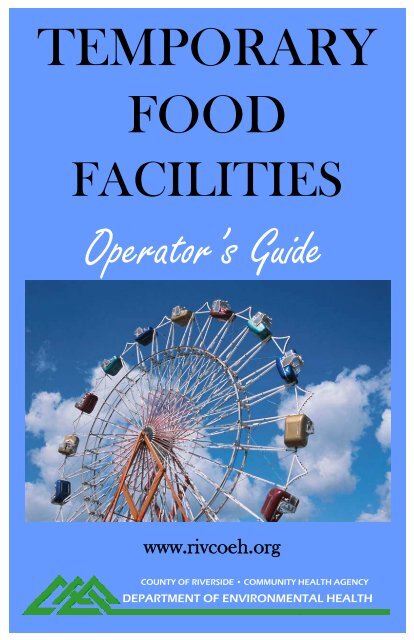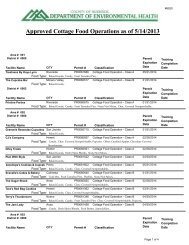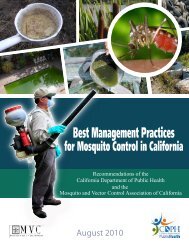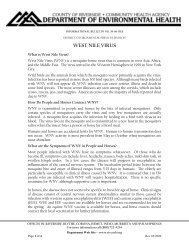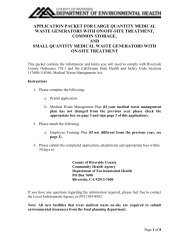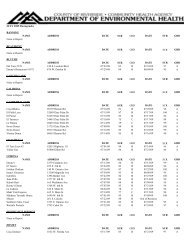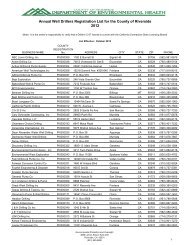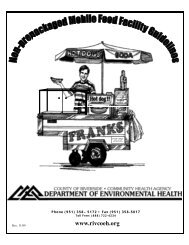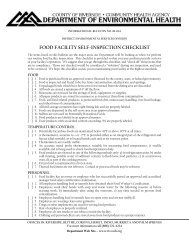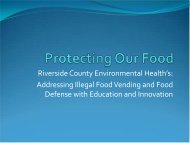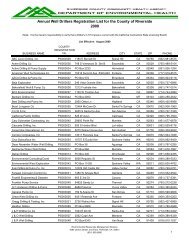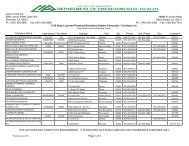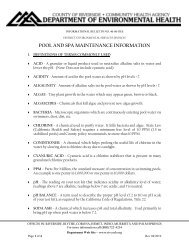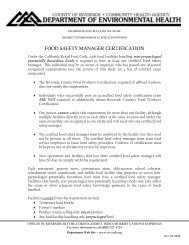Temporary Food Facilities - Riverside County Department of ...
Temporary Food Facilities - Riverside County Department of ...
Temporary Food Facilities - Riverside County Department of ...
Create successful ePaper yourself
Turn your PDF publications into a flip-book with our unique Google optimized e-Paper software.
TEMPORARY<br />
FOOD<br />
FACILITIES<br />
Operator’s Guide<br />
www.rivcoeh.org<br />
COUNTY OF RIVERSIDE • COMMUNITY HEALTH AGENCY<br />
DEPARTMENT OF ENVIRONMENTAL HEALTH
T his booklet has been developed to assist you, the food<br />
service operator, in operating a temporary food facility in<br />
a safe and sanitary manner, while complying with the<br />
requirements <strong>of</strong> the California Health and Safety Code and<br />
<strong>Riverside</strong> <strong>County</strong> Codes.<br />
While the same food handling and sanitation practices<br />
apply at a temporary food facility as they would at a<br />
permanent food facility, there are some differences.<br />
A temporary food facility usually consists <strong>of</strong> a fully<br />
enclosed tent or booth that is constructed for the duration<br />
<strong>of</strong> the event. <strong>Temporary</strong> food facilities may only operate<br />
in conjunction with community events, swap meets, or<br />
certified Farmer’s Markets that are approved by this<br />
<strong>Department</strong>. Community events must be sponsored by an<br />
organizer and have prior approval from all applicable city<br />
and county departments. Events that do not have these<br />
approvals will be limited to permitted mobile food facilities<br />
only.<br />
We hope this guide will help make<br />
your event a great success!<br />
2
DEFINITIONS<br />
POTENTIALLY HAZARDOUS FOODS - foods that are<br />
perishable and can cause illness if they are not kept hot<br />
or cold enough to keep bacteria from growing on and in<br />
them.<br />
TEMPORARY FOOD FACILITY - a food facility approved by<br />
the local enforcement agency that may be easily taken<br />
down for storage or for transportation, and assembled to<br />
its original integrity at a different location, is easily<br />
movable, and operates at a fixed location for the duration<br />
<strong>of</strong> an approved COMMUNITY EVENT...<br />
COMMUNITY EVENT - an event that is <strong>of</strong> a civic, political,<br />
public, or educational nature, including state and county<br />
fairs, city festivals, circuses, and other public gathering<br />
events approved by the local enforcement agency.<br />
In <strong>Riverside</strong> <strong>County</strong> a COMMUNITY EVENT is further<br />
broken down into the following categories:<br />
• OCCASIONAL EVENT - a COMMUNITY EVENT where<br />
TEMPORARY FOOD FACILITIES operate at a specific<br />
site for no more than 3 days in a 90 day period.<br />
• TEMPORARY EVENT - a COMMUNITY EVENT where<br />
TEMPORARY FOOD FACILITIES operate at a specific<br />
site for no longer than 25 days within a 90 day period.<br />
(This includes street fairs, the Farmer’s Fair, Indio Date<br />
Festival, etc.)<br />
3
Permit Requirements for<br />
<strong>Temporary</strong> <strong>Food</strong> <strong>Facilities</strong><br />
Every temporary food facility at a community event must<br />
have a valid Health Permit for that event. The permits are<br />
only valid for the specified site and dates. In most cases<br />
the event organizer will purchase a permit for all the food<br />
booths at their event. This is called a blanket permit<br />
because one permit covers all <strong>of</strong> the temporary food<br />
booths.<br />
On occasion, the event organizer will require the<br />
individual booths to obtain their own permit for the event.<br />
The event organizer must meet with the local<br />
Environmental Health <strong>of</strong>fice to discuss the details <strong>of</strong> the<br />
event and to purchase an “Event Organizer” Permit.<br />
All permits must be obtained a minimum <strong>of</strong><br />
two weeks prior to the start <strong>of</strong> the event.<br />
**For more information on blanket permit fees that cover multiple<br />
vendors at a community event, contact your local Environmental<br />
Health <strong>of</strong>fice or view a current copy <strong>of</strong> informational bulletin 91-01B<br />
“Permit Fees For Community Events” on our website,<br />
www.rivcoeh.org<br />
4
How should my <strong>Temporary</strong> <strong>Food</strong><br />
Facility be constructed?<br />
Unpackaged food must be stored, prepared and held for<br />
sale inside <strong>of</strong> a fully enclosed area. Typically, this means a<br />
food booth complete with a solid ro<strong>of</strong> (such as a canvas<br />
canopy) and four walls (walls can be screening <strong>of</strong> 16 mesh<br />
or finer). Screening must cover pass-through windows and<br />
other openings to minimize the entrance <strong>of</strong> insects and<br />
food contaminants. Acceptable flooring would be sealed<br />
plywood, tarps, or clean asphalt.<br />
If all <strong>of</strong> your food and beverages are pre-packaged, and<br />
you do not conduct any preparation, a fully enclosed booth<br />
is not required but some form <strong>of</strong> overhead protection must<br />
be in place over all food storage areas. Contact your local<br />
Environmental Health <strong>of</strong>fice for details.<br />
Note: Live animals and birds are not allowed inside<br />
or within 20 feet <strong>of</strong> the temporary food facility.<br />
CANOPY<br />
16 MESH SCREEN<br />
15” X 18”<br />
FOOD SERVICE<br />
OPENINGS<br />
WOOD OR<br />
PLASTIC WALLS<br />
The business name must be displayed at the booth in<br />
letters that are at least 3 inches high. The name <strong>of</strong> the<br />
owner, city, state, and zip code must be displayed in<br />
letters/numbers (at least 1 inch high) at each operating<br />
location.<br />
5
Setting Up Equipment for a<br />
<strong>Temporary</strong> <strong>Food</strong> Facility<br />
Cooking Equipment<br />
• Gas fired cooking equipment, such as barbecues, are<br />
required by <strong>Riverside</strong> <strong>County</strong> Fire <strong>Department</strong> to be<br />
outside <strong>of</strong> the temporary food facility and have a<br />
minimum <strong>of</strong> four (4) feet <strong>of</strong> clearance between the<br />
equipment and the public. These pieces <strong>of</strong> equipment<br />
may not be under any type <strong>of</strong> overhang.<br />
• All other types <strong>of</strong> cooking equipment shall remain<br />
inside the temporary food facility unless the local<br />
building and fire codes prohibit cooking inside.<br />
<strong>Food</strong> Holding and Storage<br />
• Hot holding equipment, such as chaffing dishes and<br />
steam tables, shall be placed so that they are a<br />
minimum <strong>of</strong> three (3) feet away from the pass through<br />
windows.<br />
• General food storage shall be placed a minimum <strong>of</strong> six<br />
(6) inches <strong>of</strong>f the ground. Open foods shall be stored<br />
within food grade containers.<br />
<strong>Food</strong> Contact Surfaces<br />
• All food contact surfaces shall be made <strong>of</strong> durable and<br />
easily cleanable food grade materials.<br />
Lighting<br />
• Adequate, covered lighting shall be provided for all<br />
events that occur at dusk or at night to ensure safe<br />
food handling and for cleaning purposes.<br />
Waste Disposal<br />
• All liquid waste must go to an approved<br />
sanitary sewer system.<br />
• Solid waste must be stored in leak<br />
pro<strong>of</strong> containers and disposed <strong>of</strong><br />
properly.<br />
6
Warewashing<br />
Requirements<br />
All temporary food facilities that prepare food must have a<br />
three (3) compartment sink where they can wash, rinse,<br />
and sanitize their utensils. The sink must provide potable<br />
water and have the following:<br />
• drain boards<br />
• overhead protection<br />
• HOT and COLD running water from a mixing valve<br />
**For events <strong>of</strong> three (3) days or less alternate methods may be<br />
approved by the local enforcement agency.<br />
Mobile 3-compartment sink<br />
Up to four (4) temporary food facilities may share a<br />
common utensil washing area if it is centrally located and<br />
adjacent to all <strong>of</strong> the sharing facilities. A potable water<br />
supply <strong>of</strong> twenty gallons per booth must be provided for<br />
utensil washing. This amount does not include water for<br />
food preparation. All liquid waste must be captured in a<br />
waste tank that is at least 50% greater in size than the<br />
fresh water supply.<br />
Example: 20 gallon potable supply = 30 gallon waste tank<br />
**It may be in your best interest to stock additional utensils that<br />
can be used when utensil washing may not be readily available.<br />
7
How to clean and sanitize utensils using a 3-compartment sink<br />
1. WASH... in hot, soapy water in the first compartment.<br />
2. RINSE... utensils in warm, clear water in the second compartment.<br />
3. SANITIZE... utensils in the third compartment with an approved chemical<br />
sanitizer<br />
4. AIR DRY... utensils. DO NOT use a cloth or paper towel as this may<br />
re-contaminate the utensil<br />
Detergents are used to clean prior to sanitizing. Chemical<br />
sanitizers eliminate bacteria from a clean utensil.<br />
Approved chemical sanitizers include:<br />
• Quaternary ammonium at 200 ppm for 60 seconds.<br />
• Iodine at 25 ppm for 60 seconds.<br />
• Chlorine (ie. bleach) at 100 ppm for 30 seconds.<br />
Sanitizer testing materials should be available to test<br />
chemical levels.<br />
**If chlorine bleach is used, it must be a GERMICIDAL bleach.<br />
Scented laundry bleach does not function well as a utensil<br />
sanitizer.<br />
Mobile <strong>Food</strong> Preparation Units<br />
Mobile food preparation units, or food trailers, may operate<br />
at community events but have some additional<br />
requirements to consider. In addition to the general food<br />
protection, personal hygiene, and sanitizing required <strong>of</strong> all<br />
food operations; food trailers must provide proper<br />
connections to fresh water and waste water collection<br />
containers.<br />
• Freshwater supply lines (hoses designed for potable<br />
water) are usually white with a blue stripe. These hoses<br />
must be stored in a clean and sanitary manner.<br />
• Waste water hoses should be black so they will not be<br />
mistaken for freshwater lines.<br />
• All connections must be tight and leak–free.<br />
8
Employee Hand Washing<br />
and Personal Hygiene<br />
Handwashing<br />
Hands should be washed frequently with soap and water.<br />
• A hand washing sink must be available in each<br />
temporary food facility, and be provided with HOT and<br />
COLD water from a mixing valve.<br />
• <strong>Temporary</strong> food facilities that operate for three (3)<br />
days or less may use a container that is able to provide<br />
a continuous stream <strong>of</strong> 100 o F potable water instead <strong>of</strong><br />
a traditional handwash sink. This setup must allow<br />
both hands to be free for vigorous rubbing with soap<br />
and water for at least ten to fifteen (10-15) seconds.<br />
• Liquid soap in a dispenser and paper towels must be<br />
provided at each handwash sink or station. Wastewater<br />
must be collected and emptied into an approved sewer<br />
system.<br />
Personal Hygiene<br />
<strong>Food</strong> workers must practice good personal hygiene.<br />
• Clothing should be clean and long hair confined.<br />
• Hands and forearms should be free <strong>of</strong> skin injuries.<br />
• Bare hand contact with foods should be<br />
avoided, particularly when handling ready-toeat<br />
foods. Disposable gloves may be used but<br />
must be changed as <strong>of</strong>ten as hands should be<br />
washed. Also, hands must be washed in<br />
between each change <strong>of</strong> gloves.<br />
• Hand sanitizers are allowed, but are not a replacement<br />
for handwashing.<br />
• Smoking near outside BBQ’s or within the food booth is<br />
prohibited.<br />
• No employees shall be sick while working the event.<br />
9
Temperature Control<br />
and Storage <strong>of</strong> <strong>Food</strong><br />
Cold Holding<br />
Potentially Hazardous <strong>Food</strong>s may be held at a temperature<br />
<strong>of</strong> 45°F for up to twelve (12) hours during the operating<br />
day but must be discarded in a sanitary manner at the end<br />
<strong>of</strong> the day.<br />
Hot Holding<br />
Hot Potentially Hazardous <strong>Food</strong>s must be held at or above<br />
135°F at all times. At the end <strong>of</strong> the business day any food<br />
left over must be disposed <strong>of</strong> in a sanitary manner.<br />
**Hot foods may not be cooled and stored for later use.<br />
Thermometers<br />
Probe thermometers should be used to check temperatures<br />
<strong>of</strong>ten. Make sure they are available at the temporary food<br />
facility<br />
General <strong>Food</strong> Storage<br />
All food shall be stored in approved food grade containers<br />
with lids. All food storage shall be a minimum <strong>of</strong> six (6)<br />
inches <strong>of</strong>f the ground at all times. <strong>Food</strong> should be stored so<br />
that it is adequately protected at all times from<br />
contamination, exposure to the elements, access <strong>of</strong><br />
rodents and other vermin, as well as temperature abuse.<br />
Ice is <strong>Food</strong><br />
Ice is considered to be a food, so ice for<br />
drinks and snow cones, etc. should be stored<br />
in approved containers safely away from ice<br />
used for food storage and cooling. Ice should<br />
be protected from contamination at all times.<br />
Restrooms<br />
All temporary food facilities must be located within 200 feet<br />
<strong>of</strong> the restrooms. Restrooms must be equipped with hot<br />
and cold running water, liquid soap and paper towels.<br />
10
<strong>Food</strong> Preparation,<br />
Source And Labeling<br />
<strong>Food</strong> Preparation<br />
All food preparation shall occur inside the temporary food<br />
facility enclosure or in an approved kitchen or commissary<br />
permitted by the Environmental Health <strong>Department</strong>.<br />
NO FOOD OR BEVERAGE MAY BE STORED OR MADE AT A<br />
PRIVATE HOME IF IT IS TO BE SOLD OR GIVEN AWAY TO<br />
THE PUBLIC. All ingredients must come from an approved<br />
retail source and remain free from contamination.<br />
Pre-Packaged <strong>Food</strong> Labels<br />
Prepackaged food sold directly to the customer must be<br />
prepared and packaged at an approved food facility using<br />
only food grade materials. <strong>Food</strong>s must be clearly labeled<br />
with the following information:<br />
1. Name, address and phone number <strong>of</strong> manufacturer.<br />
2. Common name <strong>of</strong> the food<br />
3. Ingredients in order <strong>of</strong> predominance by weight.<br />
4. If item is perishable it should be labeled prominently with<br />
“PERISHABLE—KEEP REFRIGERATED”<br />
in a highly visible location.<br />
11
<strong>Food</strong> Poisoning<br />
The biggest concern with any food<br />
handling operation is food poisoning.<br />
This can occur when food is not held<br />
at proper temperatures, or when the<br />
food becomes contaminated. The<br />
longer these conditions exist, the<br />
more dangerous the food can become.<br />
Bacterial growth can be controlled by<br />
keeping foods at proper temperatures,<br />
cooking foods thoroughly and washing<br />
hands frequently. Take great care to<br />
clean and sanitize cutting boards and<br />
utensils that are used with more than<br />
one type <strong>of</strong> food. This will help<br />
eliminate the possibility <strong>of</strong> passing<br />
bacteria from one food to another<br />
during the preparation stages.<br />
Careful handling during food preparation keeps food as safe<br />
as possible.<br />
You, the operator, must use the best food practices to<br />
avoid food poisoning and to guarantee the safety <strong>of</strong> the<br />
public and the success <strong>of</strong> your business.<br />
www.rivcoeh.org<br />
12
TEMPORARY FOOD FACILITY VENDOR CHECKLIST<br />
FOOD SOURCE, TEMPERATURES AND STORAGE<br />
___ <strong>Food</strong> from an approved source (NOT from home!)<br />
___ PROBE THERMOMETERS to monitor food temperatures<br />
___ A way to KEEP COLD FOODS AT 45°F OR BELOW<br />
___ A way to KEEP HOT FOODS AT 135°F OR ABOVE<br />
___ <strong>Food</strong> covered and stored at least 6 inches <strong>of</strong>f the ground<br />
HANDWASHING<br />
___ At least FIVE (5) GALLONS OF WARM WATER (100°F)<br />
___ Either a handwashing SINK, or a portable water<br />
container with a spigot that can provide a<br />
continuous stream<br />
___ CATCH BASIN for wastewater<br />
___ Liquid, anti-bacterial SOAP in pump-type dispenser<br />
___ PAPER TOWELS (not napkins)<br />
BOOTH<br />
___ FOUR (4) SIDES and a CEILING, assembled so<br />
there are limited/no gaps at each junction<br />
___ PASS-THRU WINDOWS (only large enough to pass food/money)<br />
___ Cleanable FLOORING (No dirt or grass)<br />
UTENSIL WASH (WASHING, RINSING, AND SANITIZING)<br />
___ THREE-COMPARTMENT SINK (or three containers if approved by the<br />
enforcement <strong>of</strong>ficer), large enough to hold the largest utensil.<br />
1. WASH—hot water with dish soap<br />
2. RINSE—hot water<br />
3. SANITIZE—warm water with sanitizer<br />
___ DISHWASHING SOAP<br />
___ SANITIZER<br />
• CHLORINE—100ppm for 30 seconds<br />
• Quaternary Ammonia—200ppm for<br />
60 seconds<br />
• Iodine—50ppm for 60 seconds<br />
___TESTING STRIPS to measure sanitizer level<br />
13
FOR MORE INFORMATION CONTACT<br />
THE OFFICE NEAREST YOU:<br />
2275 S. Main Street Suite 204<br />
Corona, CA 92882<br />
(951) 273-9140<br />
800 S. Sanderson #200<br />
Hemet, CA 92545<br />
(951) 766 - 2824<br />
47-950 Arabia Street Suite A<br />
Indio, CA 92201<br />
(760) 863 - 8287<br />
38740 Sky Canyon Drive, Bldg. 8<br />
Murrieta, CA 92563<br />
(951) 461 - 0284<br />
554 S. Paseo Dorotea<br />
Palm Springs, CA 92264<br />
(760) 320 - 1048<br />
4065 <strong>County</strong> Circle Drive, Suite 104<br />
<strong>Riverside</strong>, CA 92503<br />
(951) 358 - 5172<br />
14<br />
Rev (07/08)


